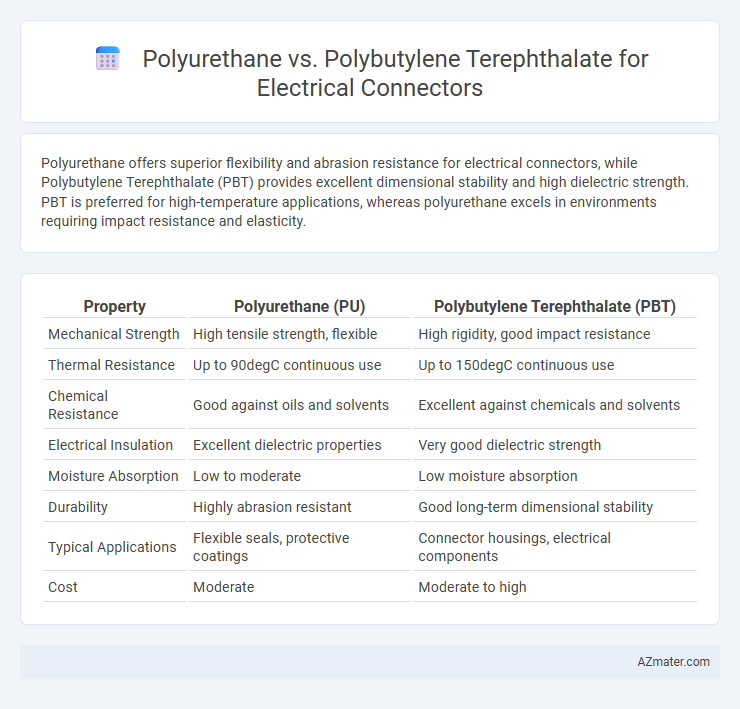Polyurethane offers superior flexibility and abrasion resistance for electrical connectors, while Polybutylene Terephthalate (PBT) provides excellent dimensional stability and high dielectric strength. PBT is preferred for high-temperature applications, whereas polyurethane excels in environments requiring impact resistance and elasticity.
Table of Comparison
| Property | Polyurethane (PU) | Polybutylene Terephthalate (PBT) |
|---|---|---|
| Mechanical Strength | High tensile strength, flexible | High rigidity, good impact resistance |
| Thermal Resistance | Up to 90degC continuous use | Up to 150degC continuous use |
| Chemical Resistance | Good against oils and solvents | Excellent against chemicals and solvents |
| Electrical Insulation | Excellent dielectric properties | Very good dielectric strength |
| Moisture Absorption | Low to moderate | Low moisture absorption |
| Durability | Highly abrasion resistant | Good long-term dimensional stability |
| Typical Applications | Flexible seals, protective coatings | Connector housings, electrical components |
| Cost | Moderate | Moderate to high |
Introduction to Polyurethane and Polybutylene Terephthalate
Polyurethane is a versatile polymer known for its excellent flexibility, abrasion resistance, and electrical insulation properties, making it suitable for electrical connector housings and sealing applications. Polybutylene terephthalate (PBT) is a thermoplastic polyester characterized by high mechanical strength, dimensional stability, and superior resistance to heat and chemicals, often used in electrical connectors requiring precision and durability. Both materials contribute distinct advantages in electrical connector manufacturing, where polyurethane offers elasticity while PBT provides rigidity and thermal endurance.
Importance of Material Selection in Electrical Connectors
Material selection in electrical connectors significantly impacts performance, durability, and safety, with polyurethane offering excellent flexibility, chemical resistance, and insulation properties ideal for dynamic applications. Polybutylene terephthalate (PBT) provides superior mechanical strength, thermal stability, and resistance to environmental stress, making it suitable for connectors exposed to high temperatures and mechanical loads. Choosing the right material ensures reliable electrical conductivity, prevents failure, and extends the lifespan of connectors in demanding electrical systems.
Chemical Structure and Composition Comparison
Polyurethane (PU) consists of repeating urethane linkages formed by the reaction between diisocyanates and polyols, offering flexibility and excellent abrasion resistance ideal for electrical connectors subject to mechanical stress. Polybutylene Terephthalate (PBT) is a semi-crystalline thermoplastic polyester composed of terephthalic acid and 1,4-butanediol, providing superior dimensional stability, high tensile strength, and chemical resistance suitable for connectors in high-temperature environments. The chemical structure of PU enables elastic and impact-absorbing properties, whereas PBT's rigid aromatic polyester backbone ensures durability and resistance to solvents, oils, and electrical insulation performance.
Mechanical Properties: Strength, Flexibility, and Durability
Polyurethane offers superior flexibility and impact resistance compared to Polybutylene Terephthalate (PBT), making it ideal for connectors subject to frequent movement or vibration. PBT exhibits higher tensile strength and greater rigidity, ensuring excellent structural stability and resistance to deformation under mechanical stress. Both materials provide strong durability, but polyurethane excels in abrasion resistance while PBT demonstrates better performance in thermal aging and chemical resistance.
Thermal Stability and Heat Resistance
Polyurethane offers excellent flexibility and impact resistance but has lower thermal stability compared to Polybutylene Terephthalate (PBT), which withstands continuous operating temperatures up to 150degC, making PBT ideal for electrical connectors exposed to high heat. PBT exhibits superior heat resistance and dimensional stability, ensuring reliable insulation integrity and mechanical strength under thermal stress. Its high melting point around 223degC allows electrical connectors to maintain performance in demanding environments where Polyurethane may degrade or deform.
Electrical Insulation and Dielectric Performance
Polyurethane offers excellent electrical insulation properties with high resistance to moisture and abrasion, making it suitable for connectors in harsh environments. Polybutylene terephthalate (PBT) exhibits superior dielectric performance due to its high dielectric strength and low dissipation factor, ensuring reliable signal integrity in electrical connectors. Both materials provide effective insulation; however, PBT is preferred in applications requiring enhanced thermal stability and dielectric efficiency.
Resistance to Chemicals and Environmental Factors
Polyurethane exhibits superior resistance to a wide range of chemicals including oils, solvents, and acids, making it ideal for electrical connectors exposed to harsh industrial environments. Polybutylene terephthalate (PBT) offers excellent resistance to environmental factors such as UV radiation, moisture, and high temperatures, ensuring long-term durability and mechanical stability in outdoor and automotive applications. While polyurethane provides flexibility and chemical resistance, PBT excels in dimensional stability and resistance to environmental aging, critical for maintaining connector performance over time.
Processing, Molding, and Manufacturing Differences
Polyurethane offers superior flexibility and excellent abrasion resistance, enabling easier processing and molding in complex electrical connector designs compared to the more rigid Polybutylene Terephthalate (PBT). PBT provides higher dimensional stability and heat resistance, which is advantageous in manufacturing connectors requiring precise tolerances and exposure to elevated temperatures. The molding cycle time for polyurethane tends to be shorter due to its lower melting point, while PBT requires higher injection molding temperatures and longer cooling times to achieve optimal mechanical properties.
Cost Analysis and Market Availability
Polyurethane offers a cost-effective solution for electrical connectors due to its lower raw material price and ease of processing compared to polybutylene terephthalate (PBT), which typically incurs higher manufacturing costs attributed to its superior thermal and mechanical properties. PBT connectors dominate the market availability, especially in automotive and industrial applications, reflecting widespread adoption driven by enhanced chemical resistance and dimensional stability. Cost analysis favors polyurethane for budget-sensitive projects, while PBT secures premium segments demanding higher performance and durability.
Applications and Suitability for Electrical Connectors
Polyurethane offers excellent flexibility, abrasion resistance, and chemical stability, making it highly suitable for electrical connectors in automotive, industrial machinery, and consumer electronics where durability and vibration resistance are crucial. Polybutylene Terephthalate (PBT) excels in high-temperature resistance, dimensional stability, and electrical insulation, ideal for connectors in telecommunications, aerospace, and automotive sectors requiring precision and long-term thermal endurance. The choice between polyurethane and PBT depends on specific application needs such as environmental exposure, mechanical stress, and thermal requirements, influencing connector performance and lifespan.

Infographic: Polyurethane vs Polybutylene Terephthalate for Electrical Connector
 azmater.com
azmater.com